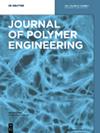用于保护石质文物的透明聚(甲基丙烯酸甲酯-丙烯酸丁酯-甲基丙烯酸六氟丁酯):合成与测试
IF 1.7
4区 工程技术
Q4 POLYMER SCIENCE
引用次数: 0
摘要
采用一锅法合成了一种透明的聚甲基丙烯酸甲酯-丙烯酸丁酯-甲基丙烯酸六氟丁酯石质文物保护材料。将合成的聚合物涂覆在石材样品或玻璃板表面。利用扫描电镜观察原始石材和石材聚合物涂层样品的微观形态。聚合物涂层的物理性质通过傅立叶变换红外光谱、X 射线衍射和 TGA-DSC 进行表征。通过测试模拟石质文物在冻融、紫外线照射和酸性老化过程中的附着力、透明度、疏水性、质量损失率和外观,研究了聚合物涂层的保护特性。结果表明,聚(MMA-BA-20.04 %HFMA)在经过冻融、紫外线老化和酸老化过程后,水接触角分别为 108.23°、109.34°和 106.96°,色度变化差值分别为 0.79、0.02 和 0.08,均优于其他聚(MMA-BA-20.04 %HFMA)。所有这些数据表明,合成的聚合物具有优异的疏水性、透明度、抗酸性、抗紫外线老化性和耐冻融性,可用于保护石质文物。本文章由计算机程序翻译,如有差异,请以英文原文为准。
Transparent poly(methyl methacrylate-butyl acrylate-hexafluorobutyl methacrylate) for conservation of stone relics: synthesis and test
A transparent poly(methyl methacrylate-butyl acrylate-hexafluorobutyl methacrylate) stone relics protective material was synthesized using one-pot method. The synthesized polymer was coated on the surface of the stone samples or glass plates. SEM was used to observe the micromorphology of pristine stone and stone covered polymer coating samples. Physical properties of polymer coatings were characterized by FTIR, XRD and TGA-DSC. The conservation properties of polymer coatings were investigated by testing adhesion, transparency, hydrophobicity, mass loss rate and appearance of the simulated stone relics after freeze–thaw, UV irradiation and acid aging processes. Results show that poly (MMA-BA-20.04 %HFMA) outperformed the others with water contact angle remained 108.23°, 109.34° and 106.96° as well as the change of chromaticity difference values of 0.79, 0.02 and 0.08, after freeze-thaw, UV-aging and acid-aging processes, respectively. All these data indicate that the as-synthesized polymer could potentially use in conservating the stone relics due to its superior hydrophobicity, transparency, anti-acid and anti-UV aging properties as well as durability for freeze–thaw.
求助全文
通过发布文献求助,成功后即可免费获取论文全文。
去求助
来源期刊

Journal of Polymer Engineering
工程技术-高分子科学
CiteScore
3.20
自引率
5.00%
发文量
95
审稿时长
2.5 months
期刊介绍:
Journal of Polymer Engineering publishes reviews, original basic and applied research contributions as well as recent technological developments in polymer engineering. Polymer engineering is a strongly interdisciplinary field and papers published by the journal may span areas such as polymer physics, polymer processing and engineering of polymer-based materials and their applications. The editors and the publisher are committed to high quality standards and rapid handling of the peer review and publication processes.
 求助内容:
求助内容: 应助结果提醒方式:
应助结果提醒方式:


